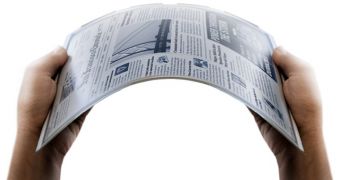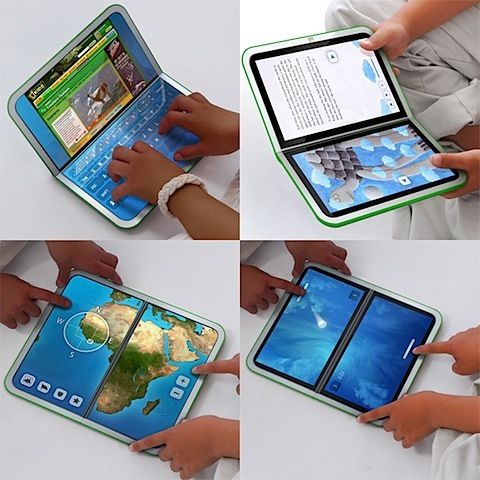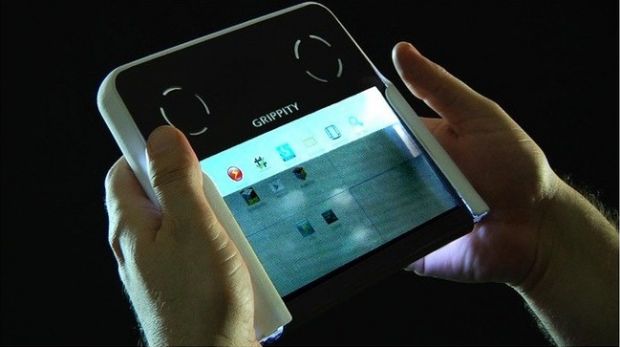We all know tablets are taking up a bigger and bigger chunk of the computing market and even is increase has been slowing down, slates continue to capture the attention of millions of customers world-wide.
But the availability of such a huge number of tablet models, has also worked against tablets per-se. The market has slowly started to become supra-saturated and a lot of brand vendors are currently struggling to compete in this fierce ecosystem.
So in order to continue to preserve a viable presence in the market, more and more companies are trying to push the boundaries of innovation, sometimes taking cues from Sc-Fi movies while doing so.
What can we expect to see in a few years’ time? Some futuristic tablet prototypes have been showcased at industry shows like CES 2014 and MWC 2014, while some new inventions have been detailed in patents, giving us a glimpse of what might be in stored for us in the near future in terms of tablets.
Tablets allowing multisensory interaction with haptics
Fujitsu is a company that’s keen on innovation and even if their products don’t come cheap, their premium features might prove to be worth the extra money.
To prove my point, Fujitsu had an impressive prototype on display on the grounds at CES 2014, a tablet bundling realistic haptic touch capabilities.
What does that mean exactly? Well imagine that when shopping online for a new dress, you’ll actually be able to feel the texture of the material the clothing item is made of, while you browse. Or you might be looking at pictures of kittens and feel their soft fur and precious whiskers.
Fujitsu offered a demo and invited curious parties to try and play a Japanese Harp by feeling and plucking the strings or touching the skin of an alligator.
While such a feature might not have a real applicability for the day-to-day life, curious minds will certainly enjoy the mélange between reality and computer generated sensations.
Tablets allowing 3D Object Interaction
For those familiar with the film Minority Report , a tablet combining the ability to play 3D games (like on the Nintendo 3DS) with Kinect / Wii type of screen interaction wouldn’t be such a surprise.
Basically, the slate could embed a system capable of creating 3D objects in space and then letting users interact with them, without the necessity of a controller or a sensor.
A new screen air technology called “3D Air-Touch” already exists and unlike Leap Motion-like sensors, the system is capable of providing its own light, via an infrared blacklight system built into the tablet’s screen.
The technology provides angular scanning illuminators located around the screen’s edges that monitors and triangulates the user’s hand position, thus making it possible to interact with 3D objects.
Bendale, Rollable, Flexible Tablets
The bendale tablet scenario is the trend du-jour. Samsung has been rumored of showcasing a bendable tablet, behind closed doors at MWC 2014, for VIP eyes only, but the information hasn’t been confirmed yet, so there’s no way of knowing such a device actually exists.
Anyway, a recent breakthrough in source-gated transistor (or SGT) technology brings us one step closer to the possibility of seeing bendable tablets become a reality.
We can imagine a real life application, for flexible display tablets, especially for those with larger screens. Like most big tablet owners would know, these devices necessitate an accessory bag of their own to be carried around. What if one could bend and fold the tablet until it was small enough to fit in your pocket?
There’s another way a bendable display could prove useful. For example, slates with larger screens could be turned into mini-laptops by virtue of folding them from the middle. A virtual keyboard could be provided on the lower part of the slate, while the upper part could act as the display.On the other hand, smaller tablets could be folded to become a smartphone companion. This actually makes a lot of sense, in the context where a lot of slates these days come with calling capabilities.
Solar-Power Tablets and Battery-less Tablets
Pixel Qi is already designing displays for mobile devices that are easy to be read outdoors as well as indoors. The company has also managed to develop a 1-Watt solar panel equipped with high-efficiency cells that can power a screen and a motherboard.
This can be achieved by virtue of placing a panel around the tablet’s bezel that could extract enough juice from sun-light to keep alive low-power tablets and eReaders. In time, solar bezels might actually replace batteries altogether, provided a technology is invented that allows them to harvest more than 1-Watt of power.
Transparent tablets
There’s a Kickstarter project called Grippity that’s looking to make this concept a reality right away. The idea behind transparent tablets is that users should be able to use more than just their two index fingers when typing on a tablet.
The solution to making this possible is a transparent, dual-side multi-touch display. Thus people would be able to type using all their ten fingers “while maintaining neutral palm posture and the ability to change between standing, sitting or lying down and leaning back.”
Being able to use all ten fingers will translate into new gestures added to the mix, when using a tablet. We’re given the example of an “intuitive opposite thumb pinching in 3D object manipulation on 2 axis simultaneously”, but the imagination is the limit with what you can do with it.
All the technologies and prototypes I have been detailing above already exists, so it’s just a matter of time before we see such products make it into the wild, at least for testing out the market, if not for popular consumption.

 14 DAY TRIAL //
14 DAY TRIAL // 



